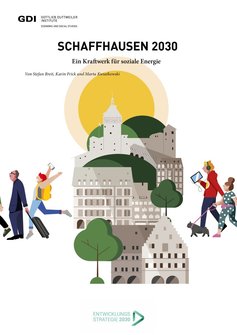Der nachfolgende Text basiert auf einem Auszug aus der GDI-Studie «Schaffhausen 2030», die Sie über unsere Website beziehen können.
Häufigere, längere und intensivere Interaktionen zwischen Menschen steigern die soziale Energie und damit die Anziehungskraft einer Region. Jedoch wirkte genau dieser Ansatz im Jahr 2020 eher wie ein Teil des Problems als wie ein Teil der Lösung. Interaktion förderte Infektion; aus dem Standortvorteil wurde ein Gesundheitsrisiko. Im übertragenen Sinn allerdings ist ansteckende Interaktion gerade das Ziel einer Regionalentwicklung, die auf die Erzeugung von sozialer Energie abzielt.
Damit kann ein Faktor hier eine Rolle spielen, der vorher nur einem Fachpublikum von Epidemiologinnen und Epidemiologen bekannt war, während der Covid-19-Pandemie aber breite Bekanntheit erreichte: der R-Wert. Die «Reproduktionszahl» gibt an, wie viele Personen eine infizierte Person im Durchschnitt ansteckt. Ist sie grösser als eins, überträgt jedeR Infizierte die Erkrankung an mindestens eine weitere Person – das Virus breitet sich aus. Ist die Zahl kleiner als eins, stecken sich immer weniger Menschen an und die Zahl der Infizierten geht zurück. Im Kontext der Regionalentwicklung lässt sich ein R-Wert für die Viralität von Interaktionen definieren: Wie ansteckend, wie anziehend ist der Austausch zwischen Menschen an einem Standort? Dieser R-Wert ist umso besser, je höher er ist: Es geht nicht um eine Ansteckung mit einer Krankheit, sondern um eine Ansteckung mit Gedankengut.
Im Buch «The Rules of Contagion: Why Things Spread – and Why They Stop» benennt der Epidemiologe Adam Kucharski vier Parameter, die das Ansteckungspotenzial eines Virus beschreiben. Auf Englisch beginnen sie mit den Anfangsbuchstaben D-O-T-S (dots, auf deutsch: Punkte).
Duration (Dauer):Opportunity (Gelegenheit):Transmission Probability (Übertragungswahrscheinlichkeit):Susceptibility (Anfälligkeit):
Diese Punkte lassen sich auf die Entstehung und Verbreitung von sozialer Energie übertragen:
Duration (Dauer):Opportunity (Gelegenheit): Transmission Probability (Übertragungswahrscheinlichkeit):Susceptibility (Anfälligkeit):
Zusätzlich aber spielt für den Grad der Empfänglichkeit auch die Atmosphäre eine Rolle, in der sich der Austausch abspielt. Diese Atmosphäre wiederum wird von der Positionierung der Region beeinflusst: Wie offen gibt sie sich, wie offen ist sie tatsächlich? Bei einer Epidemie sollen das Ansteckungsrisiko und damit der R-Wert so gering wie möglich sein.
Bei der Regionalentwicklung werden hingegen R-Werte weit über eins angestrebt. Dafür muss das Neue mit möglichst vielen Personen und Anschauungen konfrontiert werden – frische IdeenbringerInnen müssen auf «Empfängliche» treffen.
Dieser Prozess ist nicht unendlich: Sobald genügend Menschen mit dem Neuen «infiziert» wurden, ist es nicht mehr neu – die Verbreitung flacht ab oder stoppt. Aber mit der nächsten Neuerung kann er wieder von Neuem beginnen. Zur Generierung sozialer Energie wird deshalb nicht einfach nur Empfänglichkeit für eine spezifische Neuerung benötigt, sondern eine generelle Empfänglichkeit. Und dafür wird ein Mindestmass von Dynamik zwischen Ideen, Menschen und Orten gebraucht.
Diese drei Elemente müssen in einem Gleichgewicht zueinander stehen: Neue Ideen und empfängliche Menschen ohne offene Orte sind genauso unproduktiv wie empfängliche Menschen und offene Orte ohne neue Ideen. Zwei Beispiele, wie ein solches Ungleichgewicht die Umwandlung von sozialer Energie in reale Wirtschaftsleistung behindert, stammen aus zwei der wichtigsten Metropolen Europas:
BerlinLondon
Die GDI-Studie kommt zu dem Schluss, dass der Kanton Schaffhausen gerade von seiner Mittelposition zwischen Land und Metropole profitieren kann. Denn er bietet Mobilität und Stabilität zugleich, er gibt Wurzeln und verleiht zugleich Flügel. Die Verbindung scheinbar gegensätzlicher Welten kann ein produktives Spannungsfeld und damit Dynamik erzeugen.

Studie, 2021 (kostenloser Download)
Sprachen: Deutsch
Format: PDF
Im Auftrag von: Projektgruppe Entwicklungsstrategie 2030
Die Arbeitswelt im Wandel – Wie arbeiten wir nach der Pandemie?
Durch die Corona-Pandemie hat sich das Arbeitsleben radikal verändert. Statt Büroalltag und Pendeln arbeiten viele Menschen dauerhaft im Home Office. Nur Übergang oder neue Arbeitsform?
Wie der Donut unsere Städte retten kann – Podcast-Folge 24What Crisis? Wie der Donut unsere Städte retten kann
Der Einzelhandel in den Städten darbt. Die Corona-Pandemie hat den Niedergang nur noch beschleunigt. Warum gute Bürgermeister jetzt wichtiger denn je sind, und was Donuts mit Stadtplanung zu tun haben, erfahren Sie in Folge 24 des GDI-Podcasts.